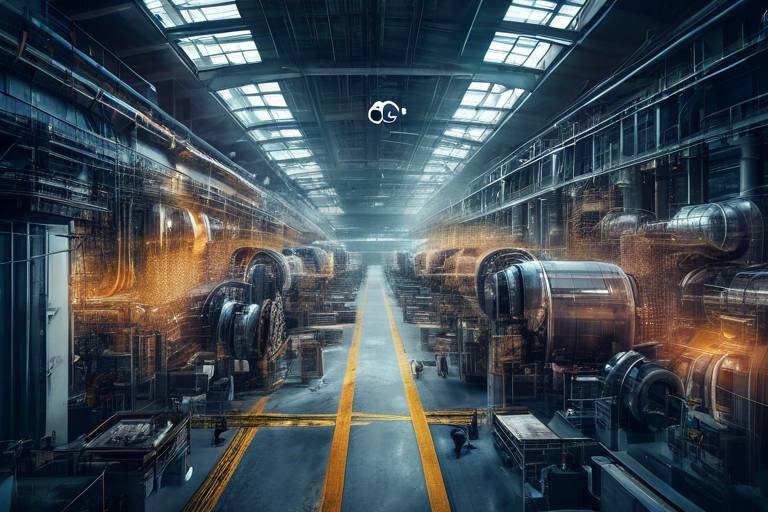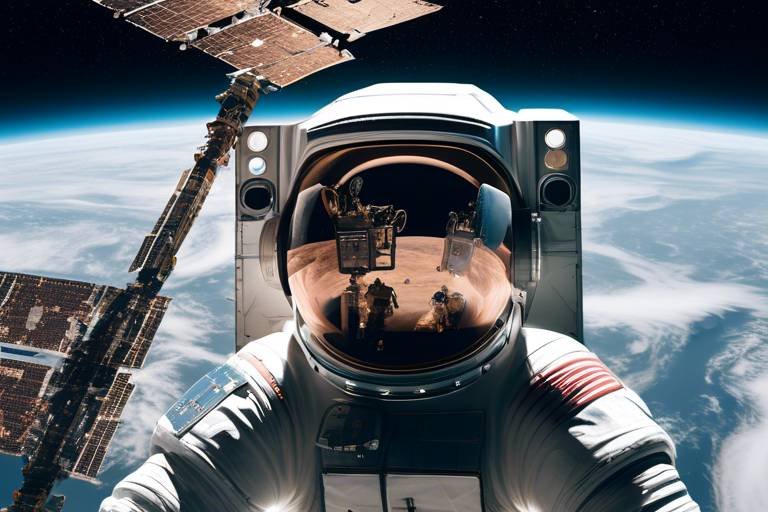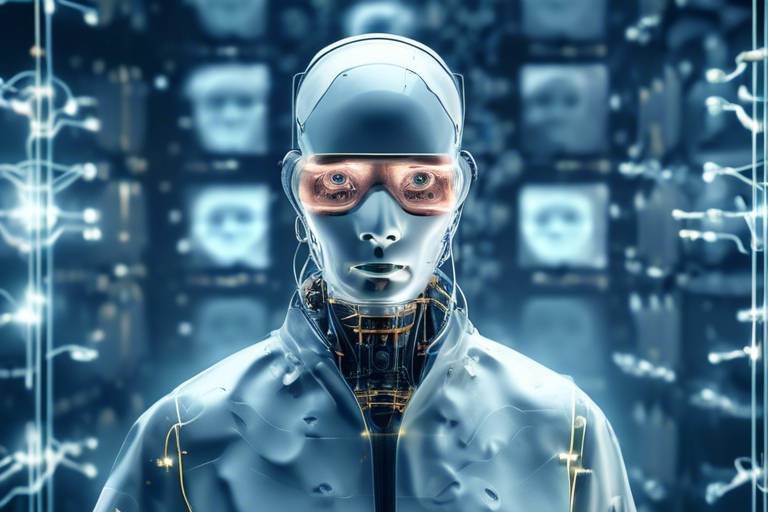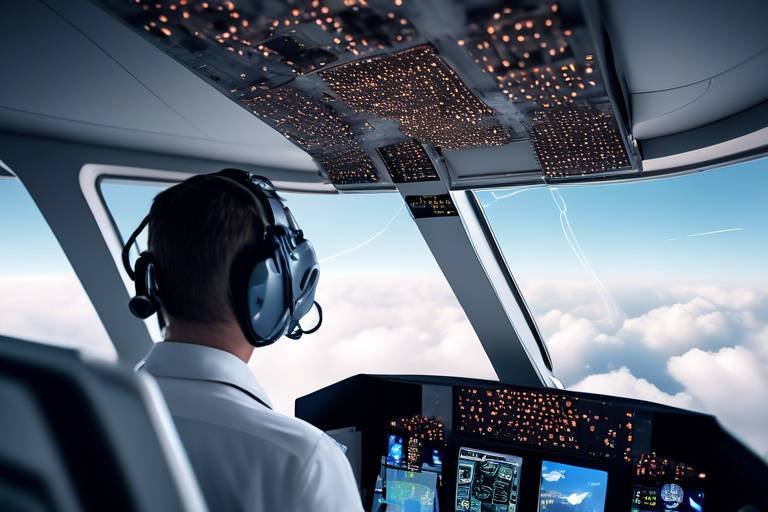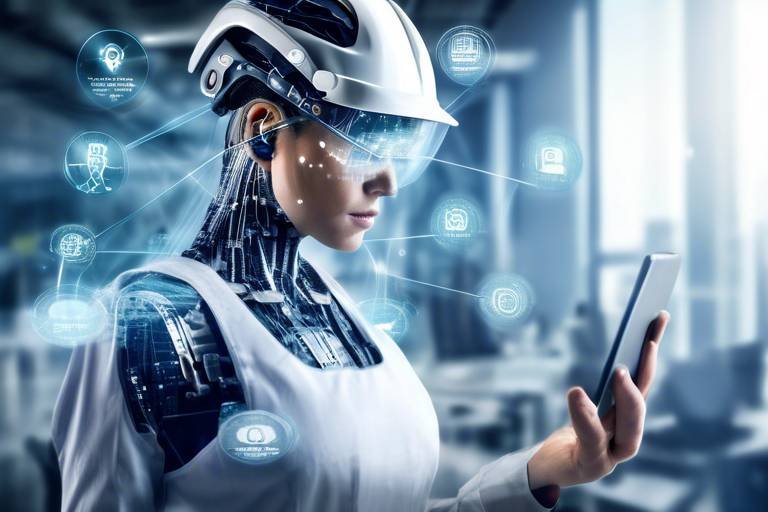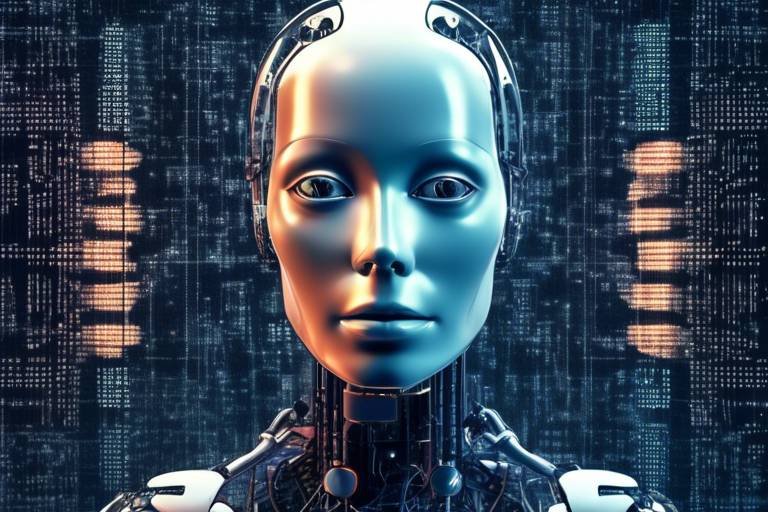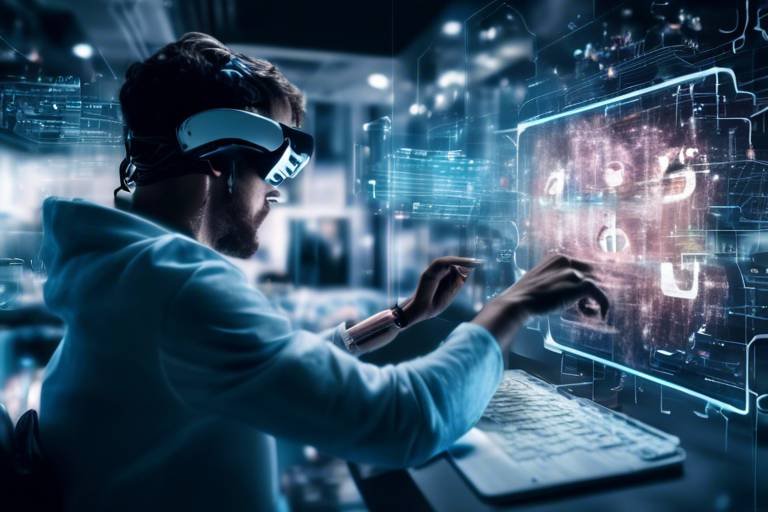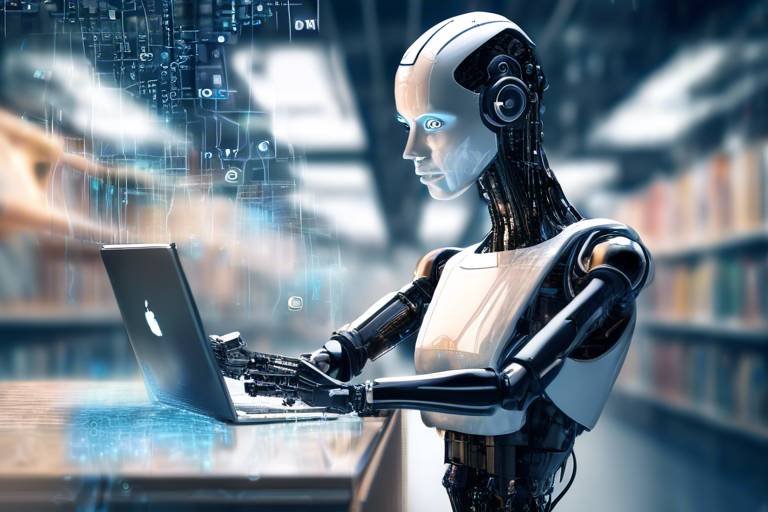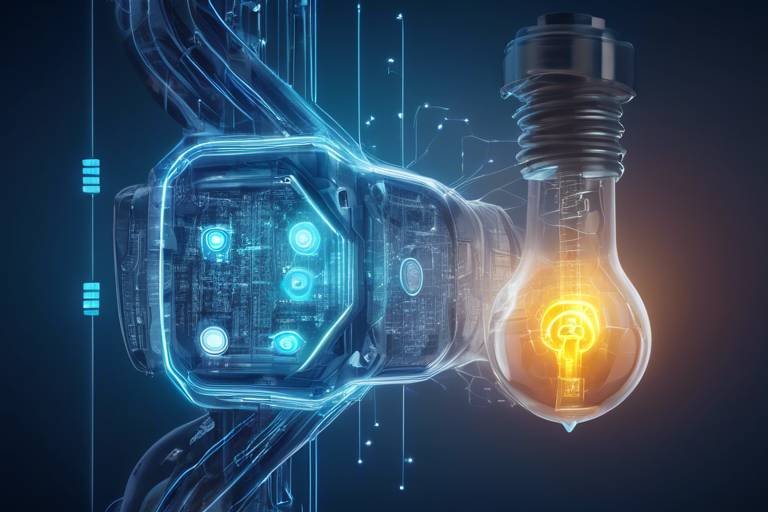Future Prospects of AI in Space Exploration
As we stand on the brink of a new era in space exploration, the role of artificial intelligence (AI) is becoming increasingly pivotal. Imagine a future where spacecraft can make autonomous decisions, robots can repair themselves, and vast amounts of data are processed in the blink of an eye. This isn't just a dream; it's the reality we're heading towards. The integration of AI in space exploration is not merely a technological advancement; it's a revolution that could redefine our understanding of the universe. From navigating the complex terrains of distant planets to analyzing the potential for life beyond Earth, AI is set to play a transformative role. As we delve deeper into this topic, we will explore the exciting applications, the challenges we face, and the future developments that promise to change the landscape of space exploration forever.
One of the most groundbreaking applications of AI in space exploration is in the realm of navigation systems. Traditional navigation systems rely heavily on pre-programmed paths and human oversight. However, with AI technologies, spacecraft can now make real-time decisions and autonomously navigate through complex environments. This capability not only enhances mission efficiency but also significantly improves safety during space travel. For instance, AI can analyze data from various sensors to detect obstacles and dynamically adjust the spacecraft's course. Imagine a spacecraft navigating through the asteroid belt, dodging debris, and making split-second decisions—all without human intervention! This level of autonomy is crucial for missions that venture far beyond our current reach, where communication delays with Earth could hinder timely decision-making.
The integration of AI into robotics is another exciting frontier. Autonomous robots are becoming the unsung heroes of space missions, capable of performing a myriad of tasks such as repairs, maintenance, and exploration without the need for human intervention. This increases mission capabilities and reduces the risks associated with sending humans into dangerous environments. For example, consider the potential of a robotic system equipped with AI that can conduct repairs on a spacecraft orbiting Mars. Instead of waiting for a human crew to arrive, these robots can assess the damage, determine the best course of action, and execute repairs autonomously. The implications for future missions are staggering, as we can send these robots to explore the surfaces of distant planets or moons, collecting data and conducting experiments in real-time.
Space missions generate an overwhelming amount of data. Here, AI shines by employing advanced algorithms that can process this data at lightning speed. By identifying patterns and insights that would be impossible for humans to discern, AI accelerates scientific discoveries. For instance, a single mission to Mars could collect terabytes of data from various sensors. AI can sift through this information, pinpointing anomalies or significant findings that scientists might otherwise overlook. This capability not only enhances our understanding of other worlds but also helps prioritize research efforts, ensuring that the most promising leads are pursued first.
Machine learning, a subset of AI, is making waves in the field of astrobiology. Researchers are using these techniques to analyze potential biosignatures on other planets and moons. By training AI models on known biosignatures from Earth, scientists can teach AI to recognize similar patterns elsewhere. This is particularly exciting in the search for extraterrestrial life. Imagine AI algorithms combing through data from missions to Europa or Enceladus, identifying signs of life that human eyes might miss. The potential for discovery is limitless, and AI is at the forefront of this quest.
AI is also revolutionizing the way we operate satellites. By optimizing performance, predicting failures, and improving communication protocols, AI increases the reliability and efficiency of satellite networks. This is crucial as we rely more on satellites for everything from weather forecasting to global communications. For example, AI can predict when a satellite is likely to fail and suggest preventative measures, thereby extending its operational life and saving costs. With AI, the future of satellite operations looks not only more efficient but also smarter.
Looking ahead, future space missions will increasingly rely on collaboration between humans and AI systems. This partnership enhances decision-making processes, allowing astronauts to focus on critical tasks while AI handles routine operations. Picture an astronaut on a distant planet, working alongside an AI system that provides real-time data analysis and suggestions. This collaboration could potentially lead to safer and more efficient missions, as both humans and AI bring their unique strengths to the table.
Despite the exciting prospects, the implementation of AI in space exploration is not without its challenges. Technical limitations, ethical considerations, and the need for robust systems that can operate in harsh environments must all be addressed. For instance, current AI technologies face hurdles such as limited processing power and reliability in extreme conditions. These challenges must be overcome to fully harness AI's potential in space exploration.
As AI systems become more autonomous, ethical questions arise regarding decision-making in critical situations. Who is responsible if an AI makes a mistake? What frameworks are needed to ensure responsible use of AI in space exploration? These questions are vital as we move forward, necessitating careful thought and planning to ensure that AI is used ethically and responsibly.
Lastly, we cannot overlook the technical limitations that current AI technologies face. Issues such as limited processing power and the ability to function reliably in extreme conditions are significant hurdles that must be addressed. As we push the boundaries of space exploration, developing AI systems that can withstand the rigors of space travel will be crucial for future missions.
- What role does AI play in navigation systems for spacecraft?
AI enhances navigation by enabling real-time decision-making and autonomous navigation, improving mission efficiency and safety. - How are robots becoming autonomous in space?
AI allows robots to perform tasks such as repairs and exploration without human intervention, increasing mission capabilities. - What is the significance of machine learning in astrobiology?
Machine learning helps researchers analyze potential biosignatures on other planets, enhancing the search for extraterrestrial life. - What challenges does AI face in space exploration?
Challenges include technical limitations, ethical considerations, and the need for robust systems that can operate in harsh environments.

AI-Powered Navigation Systems
Artificial Intelligence (AI) is not just a buzzword; it's a game-changer in the realm of space exploration, especially when it comes to navigation systems. Imagine a spacecraft that can make real-time decisions, steering itself through the vast and unpredictable cosmos. This is not science fiction—it's happening right now. AI technologies are enhancing navigation systems, allowing spacecraft to autonomously navigate complex environments. This capability significantly improves mission efficiency and safety during space travel.
One of the most fascinating aspects of AI-powered navigation is its ability to process data from various sensors and instruments onboard. These systems can analyze information about the spacecraft's surroundings, including gravitational pulls from nearby celestial bodies, potential obstacles, and even the status of the spacecraft itself. By doing so, they can adapt to changing conditions without human intervention. This level of autonomy is crucial for deep space missions, where communication delays can make real-time human guidance impractical.
Moreover, AI algorithms can incorporate machine learning techniques, which allow them to improve their performance over time. As the spacecraft encounters new environments and challenges, it learns from these experiences, refining its navigation strategies. For instance, if a spacecraft navigates through an asteroid belt, it can gather data about the movement patterns of asteroids and adjust its trajectory accordingly in future encounters. This learning capability is akin to how humans learn from their experiences, making AI-powered systems not just reactive but also proactive.
To illustrate the impact of AI on navigation systems, consider the following table that outlines some key benefits:
| Benefit | Description |
|---|---|
| Real-Time Decision Making | AI enables spacecraft to make instantaneous decisions based on current data, enhancing mission safety. |
| Autonomy | Reduces the need for constant human oversight, allowing for more complex missions. |
| Data Processing | AI can analyze vast amounts of sensor data quickly, identifying optimal paths and avoiding hazards. |
| Adaptive Learning | Through machine learning, AI systems can improve their navigation strategies based on past experiences. |
As we look to the future, the integration of AI in navigation systems will likely pave the way for even more ambitious missions. Think about sending a spacecraft to explore distant planets or moons. With AI-powered navigation, these missions can become more feasible, allowing for greater exploration and understanding of our universe. The possibilities are endless, limited only by our imagination and the technology we develop.
In conclusion, AI-powered navigation systems are revolutionizing how we approach space exploration. They provide a level of autonomy and efficiency that was previously unimaginable. As we continue to push the boundaries of what is possible in space, AI will undoubtedly play a crucial role in our journey to uncover the mysteries of the cosmos.

Autonomous Robotics in Space
When you think about space exploration, what comes to mind? Perhaps it's the image of astronauts floating in zero gravity, conducting experiments, or maybe it's the awe-inspiring sight of distant planets and stars. But behind the scenes, there’s a revolution happening—one that involves autonomous robotics. These advanced machines are not just tools; they are becoming essential partners in our quest to explore the cosmos.
Imagine a robot equipped with artificial intelligence that can perform complex tasks without human intervention. This is not science fiction; it's the reality of modern space missions. Autonomous robots are designed to handle everything from repairs and maintenance to exploration and data collection. They can navigate the harsh and unpredictable environments of space, making decisions in real-time that would be impossible for humans to execute alone. This capability not only enhances mission efficiency but also significantly reduces the risk to human life.
One of the most exciting aspects of autonomous robotics is their ability to operate in remote and hazardous environments. For instance, consider the challenges of exploring Mars. The planet's atmosphere is thin, temperatures can plunge to frigid lows, and dust storms can last for weeks. In such conditions, sending a human crew is not only risky but also impractical. Enter autonomous robots like the Mars rovers, which can traverse the Martian landscape, analyze soil samples, and send valuable data back to Earth—all without a human presence. These robots are equipped with sophisticated sensors and AI algorithms that allow them to adapt to their surroundings and make decisions on-the-fly.
Moreover, autonomous robotics are not limited to planetary exploration. They are also being deployed in spacecraft to perform maintenance tasks. For example, the International Space Station (ISS) has seen the implementation of robotic arms and drones that can conduct repairs, monitor systems, and even assist astronauts in their daily activities. This not only frees up astronauts to focus on more critical scientific endeavors but also ensures that the spacecraft remains operational and safe.
To illustrate the impact of autonomous robotics in space, let's take a look at some key applications:
| Application | Description |
|---|---|
| Planetary Exploration | Robots like the Mars rovers explore and analyze planetary surfaces, gathering data about soil, rocks, and atmosphere. |
| Satellite Maintenance | Autonomous robots can perform repairs and upgrades on satellites, extending their operational lifespans. |
| Space Station Operations | Robotic systems assist astronauts on the ISS, performing routine tasks and ensuring the station's functionality. |
As we look to the future, the role of autonomous robotics in space exploration will only expand. With advancements in machine learning and AI, these robots will become even more capable. They will learn from their experiences, improving their performance and decision-making processes over time. This self-improvement aspect is crucial, as it allows robots to adapt to unforeseen circumstances, ensuring mission success even in the most challenging environments.
However, the journey of integrating autonomous robotics into space exploration is not without its challenges. Issues such as technical limitations and the need for robust systems that can endure extreme conditions must be addressed. Nevertheless, the potential benefits are enormous. By leveraging the capabilities of autonomous robots, we can enhance our exploration efforts and unlock new discoveries that were once thought to be beyond our reach.
- What are autonomous robots? Autonomous robots are machines that can operate independently without human intervention, using AI to make decisions based on their environment.
- How do autonomous robots contribute to space exploration? They perform tasks such as exploration, data collection, and maintenance, allowing for more efficient and safer missions.
- What challenges do autonomous robots face in space? They must overcome technical limitations and adapt to extreme environmental conditions to function effectively.
- Will autonomous robots replace human astronauts? While they will assist and enhance missions, human presence will still be vital for certain tasks that require human intuition and judgment.

Data Analysis and Processing
In the realm of space exploration, the sheer volume of data generated is nothing short of astronomical. Every mission, every probe, and every satellite sends back an enormous amount of information that, if analyzed correctly, can unlock the secrets of the universe. Enter artificial intelligence, the game-changer in the field of data analysis and processing. With its ability to sift through terabytes of data in mere moments, AI is like a supercharged detective, tirelessly searching for clues that the human eye might overlook.
Imagine a scenario where a spacecraft is exploring the surface of Mars. It sends back thousands of images and readings every minute. Traditionally, scientists would spend countless hours poring over this data, searching for patterns or anomalies. However, with AI algorithms, this process becomes not only faster but also more efficient. AI can identify patterns and anomalies in the data that may indicate the presence of water, signs of past life, or even geological formations that could tell us more about the planet's history.
One of the most fascinating aspects of AI in data analysis is its ability to learn and adapt. Through machine learning, AI systems can continuously improve their performance based on the data they process. For example, if an AI algorithm is initially trained to identify specific geological features, it can refine its criteria as it encounters new data sets. This means that the more data we feed into these systems, the smarter they become. This adaptability is crucial, especially in the unpredictable environments of space where conditions can change rapidly.
Furthermore, AI's prowess isn't limited to just analyzing images or sensor data. It can also assist in predictive analytics, helping scientists forecast potential outcomes based on existing data. For instance, AI can analyze historical data from various missions to predict the likelihood of equipment failure or environmental hazards on future missions. This predictive capability is essential for mission planning and risk management, ensuring that astronauts and equipment are as safe as possible.
To illustrate the impact of AI in data processing, consider the following table that outlines key areas where AI enhances data analysis in space exploration:
| Area of Impact | AI Contribution |
|---|---|
| Image Analysis | Identifying geological features and potential biosignatures. |
| Sensor Data Interpretation | Real-time analysis of environmental conditions and anomalies. |
| Predictive Maintenance | Forecasting equipment failures and optimizing mission timelines. |
| Pattern Recognition | Detecting trends in large datasets that indicate significant findings. |
As we look to the future, the integration of AI in data analysis and processing is set to redefine our approach to space exploration. With the ability to make sense of vast amounts of data quickly and accurately, AI not only enhances our understanding of distant worlds but also accelerates the pace of scientific discovery. The potential applications are limitless, and as technology continues to evolve, we can only imagine the groundbreaking discoveries that await us in the cosmos.
- What is the role of AI in space exploration?
AI enhances navigation, data analysis, and autonomous operations, making missions more efficient and safer. - How does AI improve data analysis?
AI processes large datasets quickly, identifies patterns, and learns from new data, leading to faster scientific discoveries. - Can AI operate independently in space?
Yes, AI can perform autonomous tasks, allowing robots and spacecraft to make decisions without human intervention. - What are the challenges of using AI in space?
Challenges include technical limitations, ethical considerations, and the need for robust systems that can withstand harsh conditions.

Machine Learning in Astrobiology
Machine learning (ML) is rapidly becoming a game-changer in the field of astrobiology, the scientific study of life in the universe. Imagine trying to find a needle in a haystack, but this haystack is the vast expanse of space filled with countless planets and moons. Traditional methods of searching for biosignatures—indicators of life—are often time-consuming and require immense resources. However, with the power of AI and machine learning, researchers can sift through enormous datasets much faster and more efficiently than ever before.
One of the most exciting applications of machine learning in astrobiology is its ability to analyze data from telescopes and space missions. For instance, ML algorithms can process images captured by space telescopes, identifying potential biosignatures on distant exoplanets or moons. These algorithms can be trained to recognize specific patterns that may indicate the presence of life, such as unusual spectral signatures that suggest the existence of water or organic compounds. This capability allows scientists to narrow down their search to the most promising candidates, making the quest for extraterrestrial life more targeted and effective.
Moreover, machine learning can enhance the analysis of atmospheric compositions. By employing ML techniques, researchers can model the atmospheres of distant planets and predict how they might change over time. This predictive modeling is crucial for understanding whether these planets could support life. For example, if a planet's atmosphere shows signs of increasing greenhouse gases, it might indicate biological activity. Thus, machine learning not only helps in identifying potential life but also in understanding the environmental conditions that could support it.
In addition to finding biosignatures, machine learning can assist in the search for microbial life within our own solar system. Missions to Mars and the icy moons of Jupiter and Saturn are prime examples where ML can be utilized. For instance, the analysis of soil samples from Mars could be significantly accelerated through the use of machine learning algorithms that detect patterns indicating the presence of microbial life. This capability could lead to groundbreaking discoveries about the history of life on our planet and beyond.
Despite its immense potential, the integration of machine learning in astrobiology does not come without challenges. Researchers must ensure that the algorithms are trained on high-quality data to avoid false positives. Additionally, the ethical implications of AI decision-making in the context of astrobiology must be considered, particularly when it comes to interpreting findings that may suggest the existence of life. To address these challenges, collaboration among scientists, ethicists, and AI experts is essential.
In summary, machine learning is transforming the field of astrobiology by providing innovative tools to analyze vast amounts of data and identify potential signs of life beyond Earth. As we continue to develop these technologies, the dream of discovering extraterrestrial life may soon become a reality. The universe is waiting, and with machine learning by our side, we are better equipped than ever to explore its mysteries.
- What is machine learning in the context of astrobiology?
Machine learning in astrobiology refers to the application of AI algorithms to analyze data related to the search for life in the universe, helping researchers identify patterns and biosignatures more efficiently.
- How does machine learning help in identifying biosignatures?
Machine learning algorithms can process and analyze vast datasets from telescopes and space missions to detect specific patterns that may indicate the presence of life.
- What are the challenges of using machine learning in astrobiology?
Challenges include ensuring high-quality training data, addressing ethical implications of AI decision-making, and the need for interdisciplinary collaboration to interpret findings accurately.

AI in Satellite Operations
Artificial Intelligence is making waves in the realm of satellite operations, revolutionizing how we manage and utilize these crucial assets in space. Imagine a world where satellites can not only gather data but also analyze and respond to it in real time. This is not just a futuristic dream; it's happening right now! AI is enhancing various aspects of satellite operations, from optimizing performance to predicting failures, and improving communication protocols. This integration leads to a more efficient and reliable satellite network, which is essential for everything from weather forecasting to global communications.
One of the most significant benefits of AI in satellite operations is its ability to predict failures. Traditional methods often rely on periodic checks and maintenance schedules, which can be both time-consuming and costly. AI, on the other hand, can continuously monitor satellite health and performance, analyzing data patterns to foresee potential issues before they escalate. This proactive approach not only saves time and resources but also extends the operational lifespan of satellites. For instance, by employing machine learning algorithms, satellites can learn from past anomalies and adjust their operations accordingly, significantly reducing the risk of unexpected failures.
Moreover, AI enhances the communication protocols between satellites and ground stations. In a world where data is generated at an unprecedented rate, efficient communication is paramount. AI algorithms can optimize data transmission, ensuring that vital information is prioritized and sent without delay. This is particularly crucial during emergency situations, where timely data can make a significant difference in response efforts. By streamlining communication, AI allows for a more effective and responsive satellite network, which is essential for various applications, including disaster management and environmental monitoring.
To give you a clearer picture of how AI is transforming satellite operations, consider the following table that outlines some key applications and benefits of AI in this field:
| Application | Benefit |
|---|---|
| Predictive Maintenance | Reduces downtime and extends satellite life |
| Data Optimization | Enhances data transmission efficiency |
| Autonomous Operations | Minimizes human intervention, allowing for real-time decision-making |
| Enhanced Imaging | Improves data analysis for better insights |
As we delve deeper into the universe and expand our reliance on satellite technology, the role of AI will only grow. The future of satellite operations is not just about being able to send and receive signals; it's about creating a smart, responsive network that can adapt to changing conditions and demands. So, the next time you check the weather or use GPS, remember that AI is quietly working behind the scenes, ensuring everything runs smoothly.
In conclusion, AI's integration into satellite operations is a game-changer. It promises not only to enhance performance and reliability but also to pave the way for innovative applications that we have yet to fully explore. As technology continues to advance, we can expect even more exciting developments in this field, ultimately leading to a more connected and informed world.
- How does AI improve satellite communication?
AI optimizes data transmission by prioritizing vital information and ensuring efficient communication between satellites and ground stations. - What are the benefits of predictive maintenance in satellites?
Predictive maintenance reduces downtime, extends satellite lifespan, and minimizes unexpected failures by continuously monitoring health and performance. - Can AI operate satellites autonomously?
Yes, AI can enable autonomous operations, allowing satellites to make real-time decisions without human intervention. - What role does machine learning play in satellite operations?
Machine learning helps satellites learn from past data patterns, improving their ability to predict issues and optimize performance.

Human-AI Collaboration in Missions
As we venture further into the cosmos, the collaboration between humans and artificial intelligence (AI) is becoming increasingly vital. Imagine a scenario where astronauts are on a distant planet, tasked with conducting experiments and gathering data. In such a high-stakes environment, having a reliable AI system by their side can make all the difference. These AI systems are designed not just to assist, but to enhance the overall mission effectiveness, allowing astronauts to focus on the critical aspects of their work.
One of the most exciting aspects of this collaboration is the ability of AI to handle routine operations. For instance, while astronauts are busy conducting groundbreaking research, AI can manage the spacecraft’s systems, monitor environmental conditions, and even handle communication with mission control. This division of labor creates a more efficient workflow, enabling human crew members to dedicate their time and energy to tasks that require creativity and problem-solving skills.
Moreover, AI can act as a decision-support tool. In scenarios where quick judgments are essential, AI can analyze real-time data and provide recommendations based on historical patterns and predictive analytics. For example, if an astronaut encounters an unexpected situation, such as a malfunction in life support systems, AI can quickly assess the situation and suggest the best course of action, potentially saving lives and mission integrity.
To illustrate the potential of human-AI collaboration, consider the following table that outlines key roles AI can play in space missions:
| AI Role | Function |
|---|---|
| Data Analysis | Process and analyze scientific data in real-time, identifying patterns and anomalies. |
| System Monitoring | Continuously monitor spacecraft systems and environmental conditions, alerting astronauts to any issues. |
| Decision Support | Provide actionable insights and recommendations based on data analysis during critical situations. |
| Routine Operations | Manage day-to-day spacecraft operations, freeing astronauts to focus on more complex tasks. |
In addition to enhancing efficiency, AI also plays a crucial role in training astronauts. By simulating various scenarios, AI can help prepare astronauts for potential challenges they might face in space. This training can range from technical skills to emergency response, ensuring that the crew is well-equipped to handle any situation. The synergy between human intuition and AI's analytical prowess creates a formidable team capable of tackling the unknowns of space exploration.
However, it’s essential to recognize that human-AI collaboration is not without its challenges. Trusting AI to make critical decisions requires a robust framework that ensures transparency and accountability. Astronauts must be trained not only to work alongside AI but also to understand its limitations. As we continue to develop more sophisticated AI systems, establishing clear protocols for interaction will be paramount to the success of future missions.
In conclusion, the future of space exploration is poised for a transformation driven by the dynamic partnership between humans and AI. As we push the boundaries of what is possible, this collaboration promises to unlock new frontiers and deepen our understanding of the universe. The journey ahead may be filled with uncertainties, but with AI as a trusted ally, we can face the challenges of space exploration with confidence and curiosity.
- What is the role of AI in space exploration? AI enhances navigation, data analysis, and operational efficiency, allowing for safer and more effective missions.
- How does AI assist astronauts during missions? AI systems manage routine tasks, provide decision support, and help analyze data, enabling astronauts to focus on critical research.
- What are the challenges of using AI in space? Challenges include technical limitations, ethical considerations, and the need for robust systems that can function in harsh environments.
- Will AI replace astronauts in the future? While AI will play a significant role, it is intended to augment human capabilities rather than replace them entirely.

Challenges of AI in Space
As we stand on the brink of a new era in space exploration, the role of artificial intelligence (AI) is becoming increasingly pivotal. However, despite its immense potential, the integration of AI into space missions is not without its challenges. These obstacles can be broadly categorized into three main areas: technical limitations, ethical considerations, and the harsh realities of the space environment.
First and foremost, let’s talk about technical limitations. Current AI technologies are impressive, but they still face significant hurdles. For instance, the processing power required for complex algorithms can be a limiting factor. Spacecraft often operate in conditions where resources are scarce, and energy efficiency is paramount. Moreover, the reliability of AI systems in extreme environments, such as the intense radiation of outer space or the vacuum of Mars, poses a serious concern. Engineers and scientists must devise robust systems that can withstand these conditions without faltering. The need for highly reliable AI systems cannot be overstated, as even a minor failure could jeopardize an entire mission.
Next, we delve into the ethical considerations surrounding AI in space exploration. As AI systems become more autonomous, they will inevitably face critical decision-making scenarios that could impact human lives and mission outcomes. For example, imagine a situation where a spacecraft encounters an unexpected hazard. Should the AI make a quick decision to avoid danger, potentially risking the mission’s objectives? This raises profound ethical questions about accountability and responsibility. Who is to blame if an AI makes a decision that leads to failure? The development of frameworks that ensure responsible use of AI in these contexts is crucial. It’s not just about building smarter machines; it’s about ensuring they are programmed with a moral compass.
Lastly, we cannot ignore the harsh environments of space. The conditions beyond our atmosphere are unforgiving. Temperature extremes, cosmic radiation, and micrometeoroid impacts are just a few of the challenges that AI systems must endure. Engineers must design AI systems that can not only function but thrive in these conditions. This requires innovative engineering solutions and rigorous testing protocols. The table below summarizes some of the environmental challenges faced by AI systems in space:
| Environmental Challenge | Impact on AI Systems |
|---|---|
| Temperature Extremes | Can affect electronic components and processing capabilities. |
| Cosmic Radiation | May cause data corruption and system failures. |
| Vacuum Conditions | Challenges in cooling and maintaining system integrity. |
| Micrometeoroid Impacts | Potential physical damage to AI hardware. |
In conclusion, while the future of AI in space exploration is bright, it is essential to navigate these challenges with care and foresight. Addressing technical limitations, ethical concerns, and environmental factors will be critical in ensuring that AI can fulfill its promise in uncovering the mysteries of the universe. As we move forward, the collaboration between engineers, ethicists, and scientists will be paramount in shaping a future where AI not only enhances our capabilities but does so in a responsible and sustainable manner.
- What are the main challenges of using AI in space exploration? The main challenges include technical limitations, ethical considerations, and harsh environmental conditions.
- How does the extreme environment of space affect AI systems? Space presents temperature extremes, cosmic radiation, and vacuum conditions that can impact the functionality and reliability of AI systems.
- What ethical questions arise from the use of AI in space missions? Ethical questions include accountability for AI decisions and the implications of autonomous decision-making in critical situations.

Ethical Considerations
As we venture deeper into the cosmos, the role of artificial intelligence (AI) in space exploration raises a multitude of that cannot be overlooked. With AI systems gaining more autonomy, we must grapple with the implications of their decision-making capabilities, particularly in high-stakes scenarios where human lives and critical missions are at stake. Imagine a spacecraft on a collision course with an asteroid, where an AI must decide whether to divert the ship or maintain its current trajectory. Who is responsible for that decision? This scenario highlights the need for clear ethical frameworks that govern the actions of AI in space.
Moreover, the potential for AI to operate independently from human oversight introduces concerns about accountability. If an AI system makes a mistake, such as misinterpreting data from a distant planet, who bears the responsibility? Is it the engineers who designed the AI, the scientists who programmed it, or the space agency that deployed it? These questions demand careful consideration and a robust set of guidelines to ensure that all parties involved understand their roles and responsibilities.
Additionally, the ethical treatment of data collected during space missions is another critical aspect. AI systems will analyze vast amounts of information, including potential biosignatures from other planets. This raises questions about how we handle and interpret this data. Are we prepared to communicate findings responsibly, especially if they suggest the existence of extraterrestrial life? The implications of such discoveries could be profound, affecting everything from scientific research to public perception and policy.
Another important consideration is the impact on human jobs within the space industry. As AI takes on more tasks, there is a valid concern that it may displace human workers. While AI can enhance efficiency and reduce risks, we must also ensure that we are not sidelining the human element that is crucial for creativity, innovation, and ethical decision-making. Balancing the roles of AI and humans in space exploration will be vital to maintaining a sustainable workforce.
In summary, while the integration of AI in space exploration holds incredible promise, it also necessitates a thoughtful approach to ethical considerations. We must establish frameworks that prioritize accountability, responsible data handling, and the preservation of human roles in this exciting journey into the unknown. As we continue to push the boundaries of our understanding of the universe, let's ensure that our ethical compass guides us every step of the way.
- What are the main ethical concerns regarding AI in space exploration? The primary concerns include accountability for AI decisions, responsible data handling, and the impact on human jobs within the industry.
- How can we ensure AI systems make ethical decisions? Establishing clear ethical frameworks and guidelines for AI operations in space is essential for ensuring responsible decision-making.
- What role do humans play in missions that utilize AI? Humans will still play a crucial role in overseeing AI operations, making creative decisions, and handling complex tasks that require human intuition.

Technical Limitations
This article explores the transformative role of artificial intelligence in space exploration, examining its potential applications, challenges, and future developments that could revolutionize our understanding of the universe.
AI technologies are enhancing navigation systems, enabling spacecraft to make real-time decisions and autonomously navigate complex environments, thus improving mission efficiency and safety during space travel.
The integration of AI in robotics allows for autonomous operations in space, enabling robots to perform tasks such as repairs, maintenance, and exploration without human intervention, increasing mission capabilities.
AI algorithms can process vast amounts of data collected from space missions, identifying patterns and insights that would be impossible for humans to discern, thus accelerating scientific discoveries.
Machine learning techniques are being applied to astrobiology, helping researchers analyze potential biosignatures on other planets and moons, enhancing the search for extraterrestrial life.
AI is revolutionizing satellite operations by optimizing performance, predicting failures, and improving communication protocols, thereby increasing the reliability and efficiency of satellite networks.
Future space missions will increasingly rely on collaboration between humans and AI systems, enhancing decision-making processes and allowing astronauts to focus on critical tasks while AI handles routine operations.
Despite its potential, the implementation of AI in space exploration faces challenges, including technical limitations, ethical considerations, and the need for robust systems that can operate in harsh environments.
As we venture further into the cosmos, the of AI systems become more pronounced. Current AI technologies are often hampered by processing power constraints. For instance, the computational demands of real-time data analysis in space can exceed the capabilities of existing onboard systems. In a vacuum where every millisecond counts, delays in processing can lead to missed opportunities for critical decisions.
Moreover, the reliability of AI systems under extreme conditions poses another significant challenge. Spacecraft are subjected to harsh environments, including intense radiation and temperature fluctuations. These conditions can affect the performance of AI algorithms, leading to potential failures. For example, AI systems need to be resilient enough to withstand cosmic radiation, which can corrupt data and disrupt operations.
Additionally, the autonomy of AI systems raises concerns about their ability to handle unforeseen circumstances. While AI can process information quickly, it may not always be equipped to make the best decisions in unpredictable scenarios without human oversight. This limitation highlights the need for robust frameworks that allow AI to adapt and learn from new experiences in real-time.
To illustrate these challenges, consider the following table that summarizes some of the key technical limitations faced by AI in space exploration:
| Technical Limitation | Description |
|---|---|
| Processing Power | Insufficient computational resources to handle real-time data analysis. |
| Reliability | Vulnerability to environmental factors like radiation and extreme temperatures. |
| Autonomy | Challenges in making decisions in unpredictable scenarios without human input. |
In conclusion, while the potential for AI in space exploration is immense, overcoming these technical limitations is crucial for realizing its full capabilities. As we continue to innovate and refine AI technologies, addressing these challenges will pave the way for a new era of exploration beyond our planet.
- What are the main technical limitations of AI in space exploration?
The main limitations include processing power constraints, reliability under extreme environmental conditions, and challenges in autonomy during unpredictable scenarios.
- How does AI enhance navigation in space?
AI enhances navigation by enabling real-time decision-making and autonomous navigation, which improves mission efficiency and safety.
- Can AI operate independently in space?
While AI can perform many tasks autonomously, it often requires human oversight for critical decision-making, especially in unpredictable situations.
Frequently Asked Questions
- What role does AI play in navigation systems for space exploration?
AI significantly enhances navigation systems by enabling spacecraft to make real-time decisions. This means that instead of relying solely on pre-programmed routes, these systems can autonomously navigate complex environments, improving both mission efficiency and safety during space travel.
- How are autonomous robots contributing to space missions?
Autonomous robots equipped with AI are capable of performing various tasks without human intervention. This includes repairs, maintenance, and exploration activities, allowing for increased mission capabilities and reducing the need for astronauts to perform dangerous or tedious jobs in space.
- Can AI help in analyzing data from space missions?
Absolutely! AI algorithms can process massive amounts of data collected from space missions. They identify patterns and insights that humans might miss, which accelerates scientific discoveries and enhances our understanding of the universe.
- What is machine learning's role in astrobiology?
Machine learning techniques are being utilized in astrobiology to analyze potential biosignatures on other planets and moons. This is crucial in enhancing the search for extraterrestrial life, as it allows researchers to sift through data more efficiently and accurately.
- How is AI transforming satellite operations?
AI is revolutionizing satellite operations by optimizing performance and predicting failures. It improves communication protocols, which increases the reliability and efficiency of satellite networks, ensuring that we can maintain better connections and gather more accurate data from space.
- What are the challenges of implementing AI in space exploration?
While AI has great potential, there are several challenges to overcome. These include technical limitations like processing power and reliability in extreme conditions, as well as ethical considerations regarding autonomous decision-making in critical situations.
- What ethical considerations are associated with AI in space?
As AI systems become more autonomous, ethical questions arise about how decisions are made in critical situations. It's essential to develop frameworks that ensure responsible use of AI in space exploration, balancing innovation with ethical responsibilities.
- How do technical limitations affect AI in space?
Current AI technologies face challenges such as limited processing power and the need for reliability in harsh environments. Addressing these limitations is crucial to fully harnessing the potential of AI in space exploration and ensuring successful missions.



